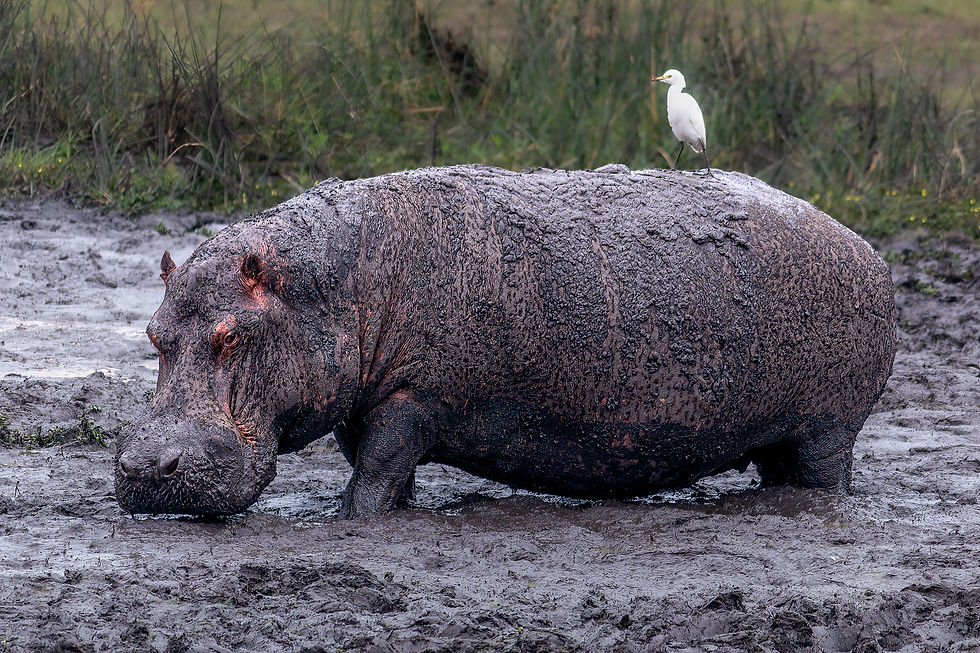Queen Elizabeth National Park Safari: Game Drives, Hippo Cruises, and the Hunt for Tree-Climbing Lions
- Rand Blimes

- May 25
- 4 min read
Updated: Oct 16

A Classic Safari, Ugandan Style
On our week-long Ugandan safari, tucked between our treks to see Uganda’s great apes—the chimpanzees of Kibale and the mountain gorillas of Bwindi—we carved out time for something different: a classic East African safari in Queen Elizabeth National Park.
This is where Uganda swaps dense jungle for open savanna. It’s home to four of the “Big Five”—lions, elephants, leopards, and buffalo (sorry, no rhino here)—along with hippos, crocodiles, and more antelope than any field guide can comfortably list.
We were here to chase big cats on game drives, float past sunbathing reptiles on boat safaris, and take in the full sweep of Uganda’s wild diversity.
Queen Elizabeth National Park: Uganda’s Big Game Safari Heartland
Queen Elizabeth National Park is one of Uganda’s most famous and most visited safari destinations—and for good reason. Established in 1952 as Kazinga National Park, it was renamed two years later in honor of Queen Elizabeth II’s visit, and it remains one of the country’s crown jewels of conservation. Set against the backdrop of the Rwenzori Mountains and cut by the equator, it’s a landscape of vast savannas, crater lakes, papyrus wetlands, and volcanic plains, all teeming with wildlife.

The original itinerary for our safari had us staying entirely in the popular northeastern sector of Queen Elizabeth National Park—and honestly, that’s where you should go if your top priority is seeing lions and maybe catching a glimpse of a leopard. The game is dense, the drives are productive, and it’s the area most set up for classic sightings.

But we were headed to Kenya’s Masai Mara after Uganda, just in time for the wildebeest migration, and we knew we were almost certain to be drowning in big cats there. So we decided to skip a second day in the busier part of the park and instead detour to the quieter, southern Ishasha sector—famous for its tree-climbing lions.
And that is the great part of booking a private tour. We simply told the tour company we wanted to change the itinerary, and they changed it.
Spoiler alert: We didn’t see the tree-climbing lions.
Second spoiler alert: We saw oodles of big cats in Kenya. So we had no regrets.
A Boat Safari on the Kazinga Channel
The highlight of Queen Elizabeth National Park was undoubtedly the boat safari on the Kazinga Channel—a natural waterway linking Lake Edward and Lake George, and a magnet for wildlife.

But this cruise isn’t just relaxing—it’s teeming with life. We glided past herds of bathing elephants, pods of grumpy hippos, and lazy buffalo lounging like tired tourists at the water’s edge. Crocodiles sunned themselves on the banks, looking like logs with teeth. The birdlife? Spectacular. African fish eagles, kingfishers, and yellow-billed storks all made appearances—perching, hunting, preening. If you’ve ever wondered what a wildlife documentary feels like in person, this is it.

At one point, our boat drifted near the shore to get a better look at an enormous Nile crocodile, dozing by the water. Then, out of nowhere, the head of a monitor lizard popped up—nervous, twitchy, and very clearly up to something. Turned out it was digging in the crocodile’s nest, looking for an omelet dinner. It would dig furiously for a few seconds, then freeze—lifting its head to make sure mama croc was still snoozing. Dig. Look. Dig. Look.
Eventually, the crocodile caught on and lunged. The lizard fled—but only temporarily. Once mama croc settled back down, the relentlessly hungry lizard returned and resumed its egg-thieving excavation. I’ve seen a lot of wild moments in my travels, but this? This was the most National Geographic thing I’ve ever witnessed.

The channel was also full of hippos. Most of the time, they lounged half-submerged in the water or packed together into hippo puddles—mud, water, and bulk all blending into one immovable mass. But now and then, a sudden spray of water and a burst of thrashing would remind us that somewhere in the pod, a hippo was having a bad day.

The birds of Queen Elizabeth National Park seemed unusually cooperative—perching photogenically on the backs of hippos and buffalo, striking just the right pose for passing photographers.

Our experience along the Kazinga Channel was so rich, so full of life, we didn’t even mind that we hadn’t seen any big cats. For that, we still had one more shot.
Looking for Lions in the Trees of Ishasha
The next morning, we rose early and ventured out to Ishasha.
Tucked into the far southern edge of Queen Elizabeth National Park, Ishasha is remote, quiet, and wild. There are no boat safaris here, no lines of safari trucks, no certainty of sightings. But Ishasha has one thing that almost nowhere else in Africa does: tree-climbing lions.

That is, if you’re lucky.
We weren’t.
But we did have a fun, unhurried day cruising the savanna, standing up through the open roof, scanning the horizon for anything that vaguely resembled a lion. And in the golden grasses of the savanna, let me tell you: everything looks like it might be a lion. There were more than a few false alarms.
That was our day.
We didn’t see much at all in Ishasha. Sometimes you take a risk and it doesn’t pay off. That’s just how the world works.
I really wanted to see one of the big, deadly kitty cats napping in a tree. I didn’t. But I was okay with that. Because travel teaches one of the most important life skills: learning to sit with disappointment. So I took the hit.
And then we turned our sights west, toward Bwindi Impenetrable Forest—and the waiting mountain gorillas.



Comments